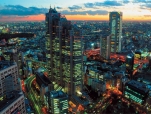Tokyo – Moscow: City-Space Development

MOSCOW is in transition! The most populous city on the continent of Europe is expanding. Under a new plan signed off by the city’s Mayor Sergei Sobyanin in July 2011, Moscow will double in size.
I am sure this has raised skepticism among many including some of the audience here, because the global trend is to curb the sprawl and make cities more compact, more energy efficient, greater densities, with less commuting distance. With the new sub center located on southwest to Moscow, there is a fear that commuters living north will have to pass through center or MKAD to reach the southwest, which will increase the stress on already suffocated historic center, neither shorten the commuting distance.
However I would like to argue differently, and would like to share with you some ideas from Tokyo, a city where I spent considerable time of my live observing its evolution for the past 15 years. With its neighboring cities Kawasaki and Yokohama, Tokyo is considered to be one of the most populated urban conglomerates on earth. However if we look at Tokyo’s population density in isolation from Kawasaki and Yokohama and compare it to Moscow, surprisingly we find that Moscow is as twice crowded than Tokyo.
Today the population density of Moscow exceeds 1,000 persons per sq.m. km., causing continuing congestion, notorious traffic jams, air pollution, and enormous pressure on historic center. Beautiful old buildings are rapidly disappearing to be replaced with larger new buildings, which bring even more traffic to the historic city center. Due to lack of underground space for parking, cars are parked along the roads clogging the arteries of the city. Moscow is in need for expansion.
Recently Moscow witnessed birth of the new sub centers, such as Moscow City which is the first large scale mixed area to combine business activity, living space and entertainment in one single development. Metropoliya is another large-scale mixed use sub center being developed in the south east part of Moscow. But are these sub centers enough? Tokyo has at least 9 centers equivalent to Moscow City and Metropoliya. Tokyo is a highly developed polycentric city with developed underground network. In the Empire of Signs, Roland Barth, a renowned French theorist, philosopher and semiotician, describes the center of Tokyo, the Emperor’s Palace, as a silent and non-descript presence, avoided and unconsidered.
Full version you can download here
 Text by Fadi Jabri, General Manager of Nikken Sekkei Dubai office
Text by Fadi Jabri, General Manager of Nikken Sekkei Dubai office


